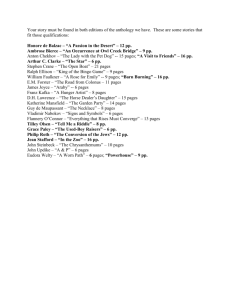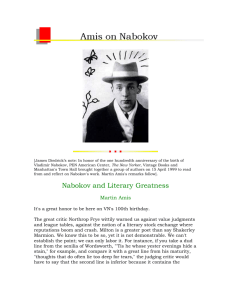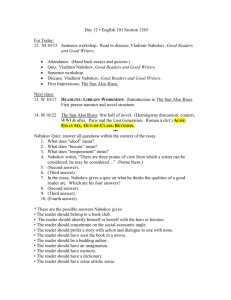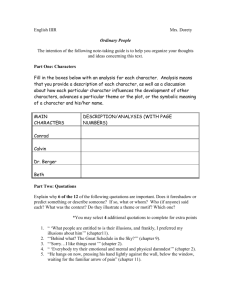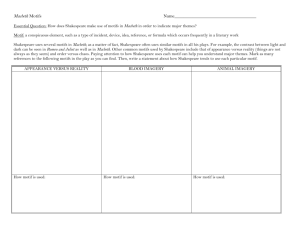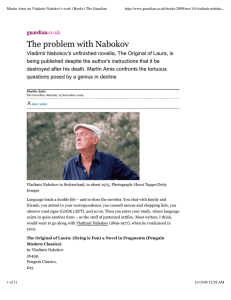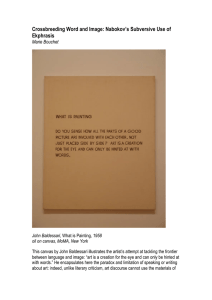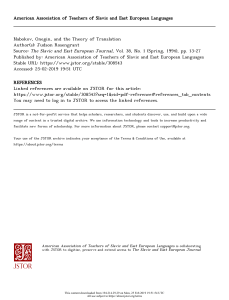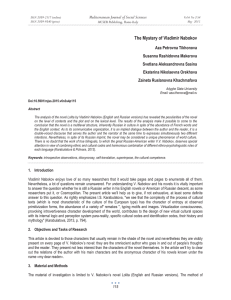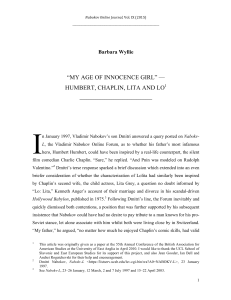10 February 2014
advertisement
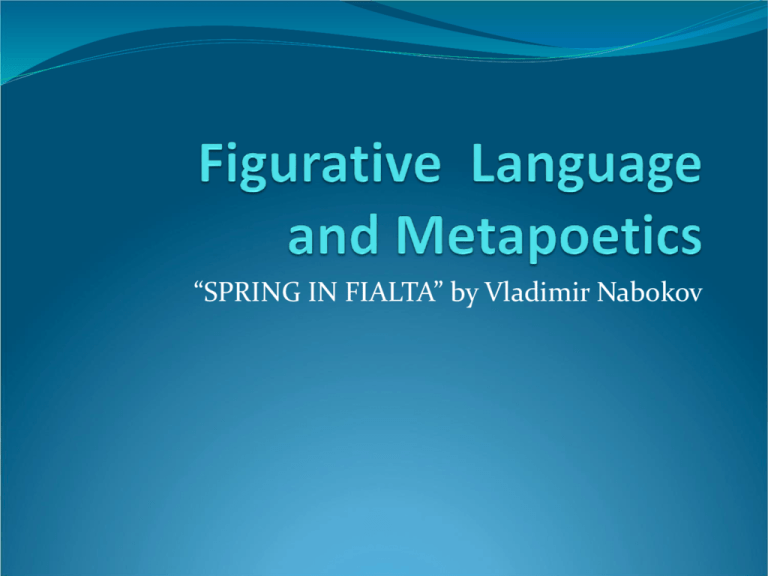
“SPRING IN FIALTA” by Vladimir Nabokov Vladimir Nabokov (1899 – 1977) Russian and American poet, novelist, short-story writer, literary critic, translator, and entomologist. Born in Saint-Petersburg into the family of a prominent politician. Emigrated to Europe after the revolution of 1917. Studied in Cambridge. Moved to the US in 1940. Taught literature. Made a transition to writing in English. The success of Lolita (1955). Moved back to Europe. Died in Switzerland. Vladimir Nabokov in his own words “I was born on the same day as Shakespeare, a hundred years after Pushkin.” “I am an American writer born in Russia, educated in England, where I studied French literature before moving to Germany for fifteen years.” “My mind speaks English, my heart speaks Russian, and my ear prefers French.” Vladimir Nabokov Symmetry: eight Russian and eight American novels (plus one unfinished in each language). Interests: books, butterflies, and chess problems (Poems and Problems, 1971). Nabokov’s Complex Style of Writing: Figurative Language Word play (p.289) Similes (p.291, 294, 296) Elaborate metaphors* (p.292, 304) Alliterations* (p.289 the opening phrase) Personification* (p. 290, 291, 293) Allusions* (p.291) Figures of Speech *Alliteration A pattern of repeated identical or similar consonant sounds. *Allusion An indirect reference to some piece of knowledge not actually mentioned. Allusions usually come from a body of information that the author presumes the reader will know. For example, an author who writes, “She was another Helen,” is alluding to the proverbial beauty of Helen of Troy. http://dictionary.reference.com/browse/allusion Figures of Speech (Figurative Language) *Metaphor A figure of speech in which a term or phrase is applied to something to which it is not literally applicable in order to suggest a resemblance, as in “A mighty fortress is our God.” http://dictionary.reference.com/browse/metaphor *Personification An artistic device of representing an inanimate object or an abstract idea as a living creature or a person. Nabokov’s Style of Writing Hidden quotes (p.289 Chekhov; p.311 Pushkin) Metapoetics (p.292, 299, 308) The figure of the author within his own text (an “Englishman,” p. 290, 291, 307, 309). Synesthesia (p.289) Extra-long sentences. Note the use of semi-colons (p. 297). “Chinese box” of imagery: Allusions* (p.289, 292, 294, 300) Alexander Pushkin Thou and You She substituted, by a chance, For empty "you" — the gentle "thou"; And all my happy dreams, at once, In loving heart again resound. In bliss and silence do I stay, Unable to maintain my role: "Oh, how sweet you are!" I say — "How I love thee!" says my soul. Compare to p.311 “SPRING IN FIALTA” “ I said (substituting for our cheap, formal ‘thou’ that strangely full and expressive ‘you’ to which the circumnavigator, enriched all round, returns), ‘Look here – what if I love you?’” (311). What is the difference between the original poem by Pushkin and Nabokov’s hidden quote? “Spring in Fialta” “Mechanics” of memory (p. 292, 293, 301 (Nina), 305, 310). Nina’s portrait drawn with words (p.304). Literature’s power of preserving fleeting life. Non-events, non-affair. Foreshadowing and the opposite of dramatic irony p. 307. Time and tenses (p. 292). Spiral time in the last sentence. Motifs* of history, trains, music, and many more. MOTIF (academic definition) • mōtēfˈ, in literature, term that denotes the recurrent presence of certain character types, objects, settings, or situations in diverse genres and periods of folklore and literature. Examples of motifs include swords, money, food, jewels, forests, oceans, castles, dungeons, tests of skill or wisdom, journeys, separations and reunions, chaos brought to order. Motifs are not restricted to literature. Hans von Wolzogen coined the term leitmotiv [Ger.,=guiding motive] to describe Richard Wagner's use of a recurring musical phrase to reinforce the emotional impact of characters, situations, and themes in his operas. The visual arts often rely on motifs to communicate deeper levels of meaning: The bison and deer painted on the walls of the caves at Lascaux represent both threat and survival, superior strength or speed, and food supply; the endlessly rocking cradle in D. W. Griffith's film Intolerance suggests rebirth and the inescapable frailties of the human condition (see symbol ; archetype ). The Columbia Encyclopedia, Sixth Edition.New York: Columbia University, 2007. P. 33053. MOTIF (in simple words) “A motif is a detail within the story that repeats itself throughout the work. Examples of common motifs include colors, character traits, objects, locations, or situations. The sky's the limit, really. What makes something a motif is when it shows up several times throughout the story. Think of them as breadcrumbs left by the author to draw your attention toward something important in the theme or message of the story.” CliffsNotes.com. What is a motif, and how can I find them in Macbeth? 29 Jan 2010<http://www.cliffsnotes.com/ Section/id-305403,articleId-8033.html>.


